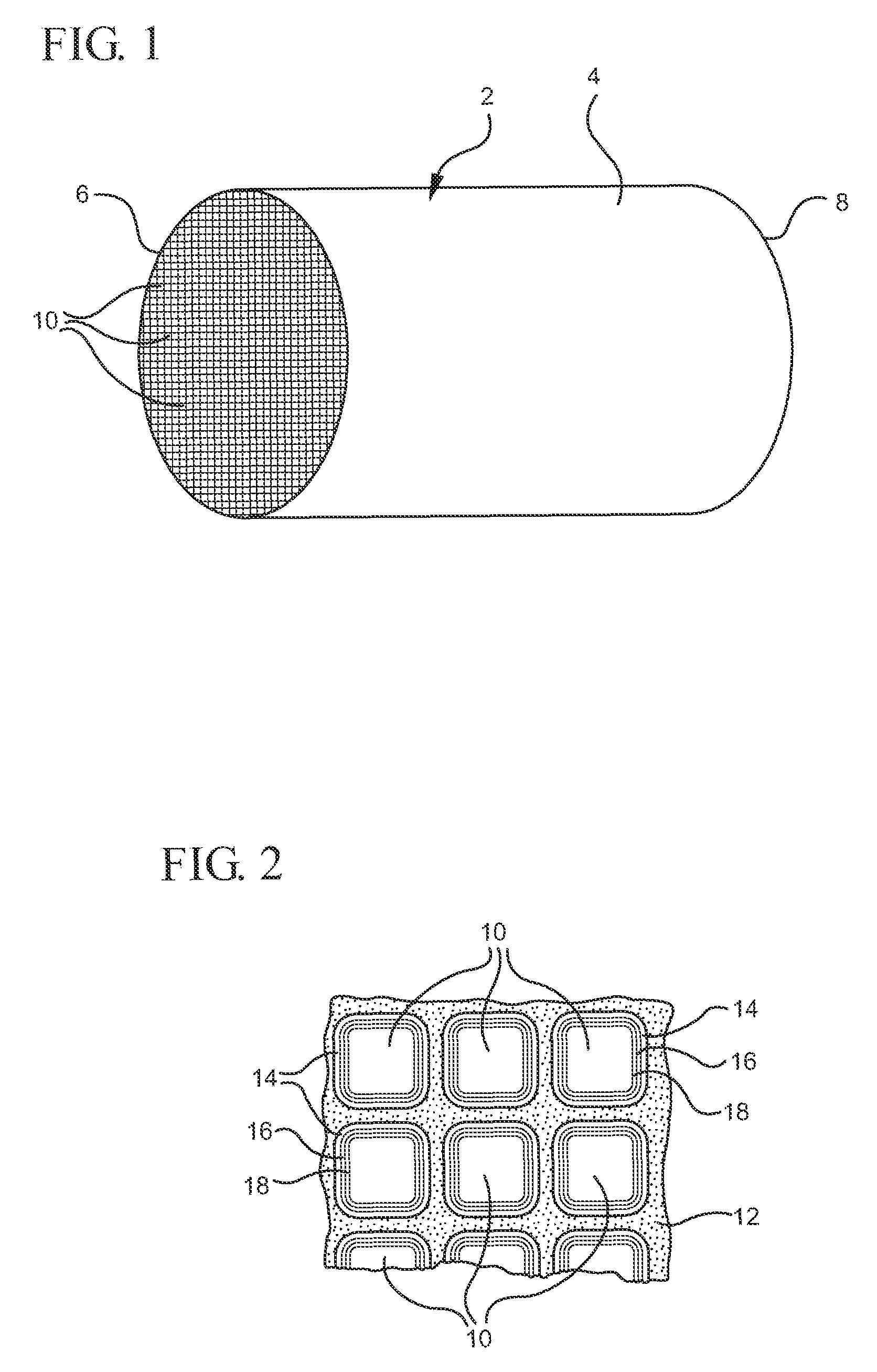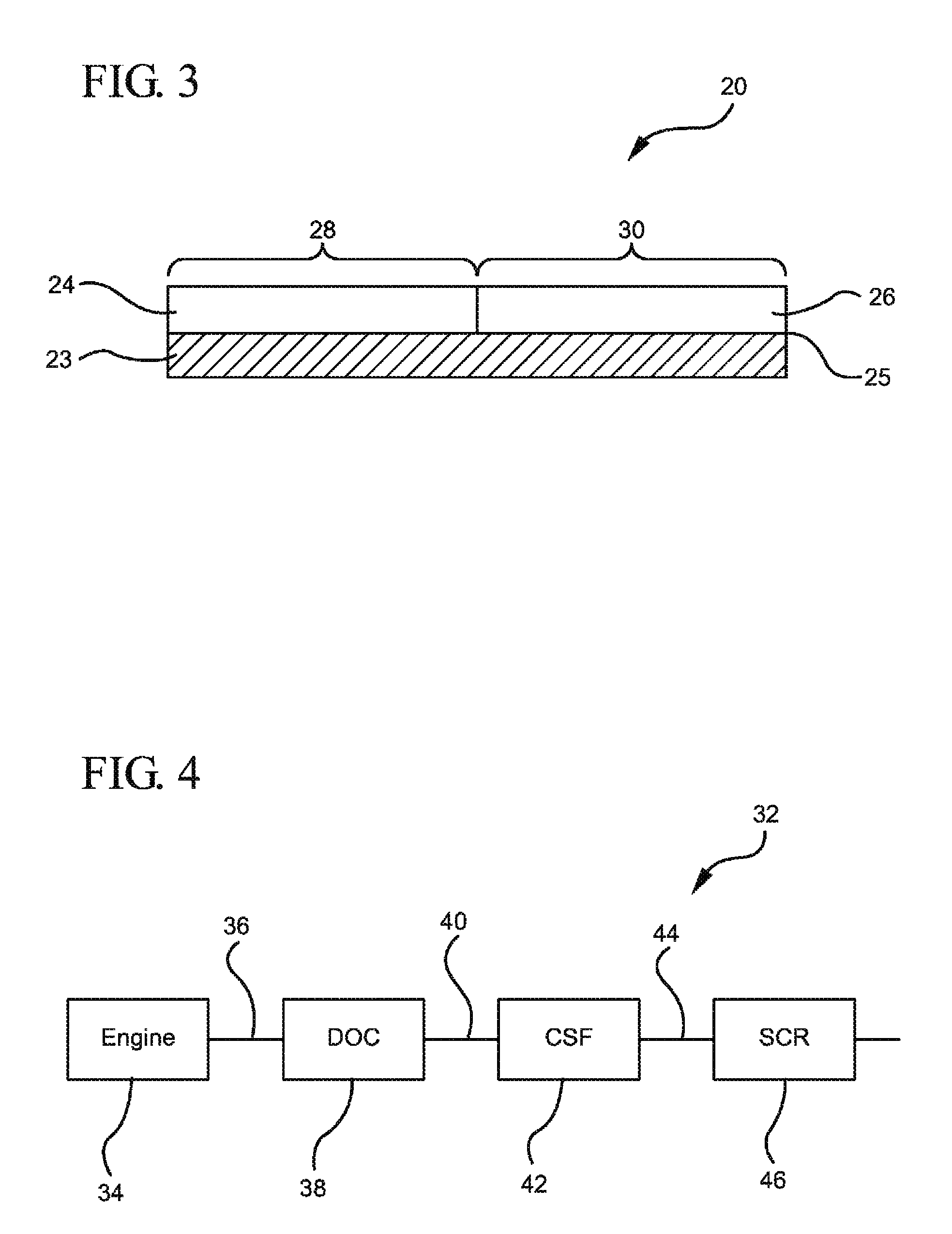Oxidation catalyst with low CO and HC light-off and systems and methods
a catalyst and low co technology, applied in the direction of metal/metal-oxide/metal-hydroxide catalysts, machines/engines, arsenic compounds, etc., can solve the problems of less effective catalysts used to treat the exhaust of internal combustion engines, health risks, and more severe problems of diesel engines
- Summary
- Abstract
- Description
- Claims
- Application Information
AI Technical Summary
Benefits of technology
Problems solved by technology
Method used
Image
Examples
second embodiment
In a second embodiment, in addition to an undercoat, and a first washcoat layer, a catalyst is provided which includes a second washcoat layer coated over said first washcoat layer comprising a support material, one or more hydrocarbon storage components, and a precious metal catalyst containing one or more of platinum (Pt) and palladium (Pd). In one embodiment, the hydrocarbon storage component in the undercoat and / or the second coat comprises a zeolite. Non-limiting examples of zeolites include faujasite, chabazite, clinoptilolite, mordenite, silicalite, zeolite X, zeolite Y, ultrastable zeolite Y, ZSM zeolite, offretite, and beta zeolite or combination thereof. In a highly specific embodiment, the zeolite comprises beta-zeolite. In other embodiments, the hydrocarbon storage component may comprise silicoaluminophosphates, aluminophosphates, and combinations thereof.
According to one or more embodiments, the under coat may contain a refractory oxide selected from alumina, ceria-zirc...
example 2
Catalyst IR-1
This catalyst contained two layers. The bottom (undercoat) layer used the same slurry in reference catalyst of Comparative Example 1 (no precious metal). It was coated onto cordierite substrate, dried and calcined as in Comparative Example 1. The second (top) layer was made by impregnating Pd (66 g / ft3) onto a CeO2—ZrO2—Al2O3 support. The composition of the support was (CeO2=12.5, ZrO2=12.5, and Al2O3=75%). The Pd concentration was about 2.1%. The Pd / CeO2—ZrO2—Al2O3 support was then made into slurry (42% solid) and milled with Ba acetate to a particle size of 90% less than 10 microns. The slurry was then coated over the under coat, dried and calcined at 550° C. for 2 h. The wash coat gain was 1.8 g / in3. The wash coat composition was: PdO=0.0386 g / in3, Pd / Support=1.75 g / in3, and BaO=0.05 g / in3.
example 3
Catalyst IR-2
This catalyst contained two layers. The bottom (undercoat) layer was same slurry in Comparative Example 1 (no precious metal). It was coated onto cordierite substrate, dried and calcined as in Comparative Example 1. The second (top) layer was made by impregnating Pd (66 g / ft3) onto a CeO2—ZrO2 composite material made of CeO2=45%, ZrO2=45%, NdO=5% and Pr6O11=5% support. The Pd concentration is about 2.3%. The Pd / CeO2—ZrO2 support was then made into slurry (42% solid) and milled with Ba acetate and alumina binder to a particle size of 90% less than 10 microns. The slurry was then coated over the under-coat, dried and calcined at 550° C. for 2 h. The wash coat gain was 1.8 g / in3. The wash coat composition was: PdO=0.0386 g / in3, Pd / Support=1.65 g / in3, alumina binder=0.1 g / in3, and BaO=0.025 g / in3.
Catalyst Aging and Evaluation:
Each catalyst was aged was aged in a tube furnace at 800° C. using 10% steam in air for 12 hours. The catalyst was cooled down and moved into a lab re...
PUM
| Property | Measurement | Unit |
|---|---|---|
| temperatures | aaaaa | aaaaa |
| wall thickness | aaaaa | aaaaa |
| wall thickness | aaaaa | aaaaa |
Abstract
Description
Claims
Application Information
 Login to View More
Login to View More - R&D
- Intellectual Property
- Life Sciences
- Materials
- Tech Scout
- Unparalleled Data Quality
- Higher Quality Content
- 60% Fewer Hallucinations
Browse by: Latest US Patents, China's latest patents, Technical Efficacy Thesaurus, Application Domain, Technology Topic, Popular Technical Reports.
© 2025 PatSnap. All rights reserved.Legal|Privacy policy|Modern Slavery Act Transparency Statement|Sitemap|About US| Contact US: help@patsnap.com



